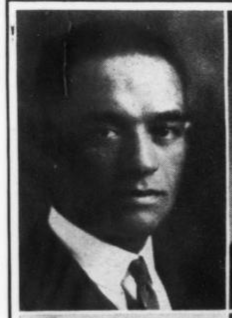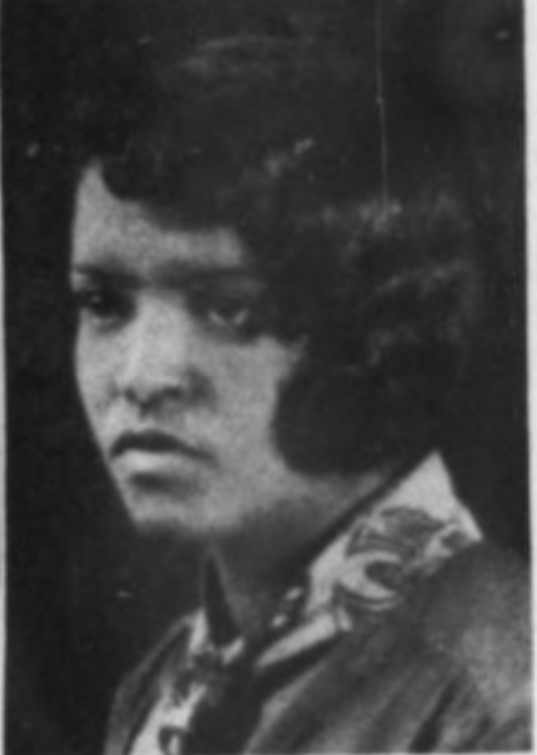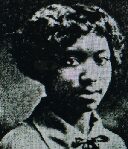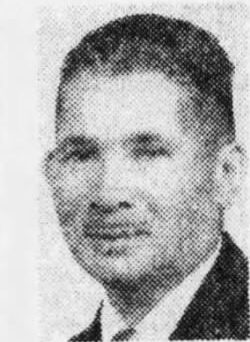Thomasson, Maurice E. (B.S., Sociology, 1926)
Maurice Ethan Thomasson was born 5 May 1892 in Monticello, Arkansas, the son of James E. Thomasson, a shop owner, and Isabella Brooks Thomasson. After studying at Hampton Normal and Agricultural Institute, Maurice earned a Bachelor’s degree from Iowa State College in 1926. At that time, Thomasson was one of only 13 Black regular session students at ISC (“A Record,” 1926). He graduated along with classmates Compton Chapman, Benjamin Crutcher, and Willa Juanita Ewing.
followed by a Master’s degree in sociology from the University of Minnesota and a doctoral degree from Columbia University. Thomasson became a faculty member at Johnson C. Smith University, an HBCU in Charlotte, North Carolina, after earning his doctorate. In 1941, He took up his post at the Delaware State College for Colored Students (now Delaware State University).
Thomasson married La Verne Boyer on 4 June 1947, the year that his employing institution became known as Delaware State College. He and his wife taught sociology at the school, Delaware’s only HBCU, from the 1940s through the 1960s. After turmoil at the college surrounding student dissatisfaction regarding campus infrastructure that was unable to support the influx of World War II veterans on the G.I. Bill, Thomasson was appointed to serve as acting president of the college in 1949. He returned to his position as faculty head of sociology studies after the hiring of a new president in 1950 but was appointed a second time as acting president in mid-1951, the college wanting to tap him permanently for the role. Thomasson, however, turned down the offer, stating his desire to teach. (Holmes, 2014)
During this second term as Acting President, in 1952, Thomasson was called upon to testify at a landmark Delaware integration trial that considered consolidated court cases Gebhart v. Belton and Bulah v. Gebhart. Thomasson’s “sociological perspective” on segregated schools was recorded in the trial transcript:
I don’t think that in a segregated situation it is possible to produce a person who is fully normal, completely satisfactory. There are some conditions inherent in the segregated situation that just simply warp a person’s personality. Now, for one thing a person who goes to school in a segregated school goes to that school by virtue of the fact that the State of which he is a part has said he is inferior. That is, the State has embodied that in the law, and the law has been sustained by the courts. He is told as he goes there the school segregated by law that he is inferior. (Holmes, 2014).
Donald Evans, a former student of Thomasson’s, remembered his former professor’s demeanor as unsuited to being a president of a university: “He was a very nice man, but I don’t think he had the personality to be a (permanent) president of a University” (quoted in Holmes, 2014). For the rest of his academic career, Thomasson taught sociology before retiring from teaching in 1967.
He died on 8 September 1973 and was buried in Odd Fellows Cemetery in Smyrna, Delaware. Delaware State University’s Thomasson Hall and Maurice Thomasson Center are named after him.
Sources
Photo credit: A record of the Negro at college 1926. (1926, August). The crisis: A record of the darker races, p. 187.
A record of the Negro at college 1926. (1926, August). The crisis: A record of the darker races, p. 174.
Holmes, Carlos. (2014, Feb. 12). Dr. Maurice Thomasson carried on work during trying times, declined permanent president post. Delaware State University, Dept. of Human Ecology [Blog]. Accessed 12 Dec. 2021. [No longer available.]
Ewing, Willa Juanita (B.S., Botany, 1926; M.S., Horticulture, 1935)
Willa Juanita Ewing, known as “Juanita,” was born 29 December 1903 in Keytesville, Missouri, to William Ewing and his wife Lee Ewing. Juanita’s mother married several times which resulted in Juanita’s name changing in her youth. Leaving her first husband in Missouri, Lee moved with her young daughter to Des Moines, where she married Edwin H. Carter. The Carter family moved to Ames in 1915, becoming one of the earliest known Black families in the community. By 1920 Lee was a widow, working as a housekeeper at the Tri Delta house and living there with her daughter, called “Waneeta Carter” in the 1920 census. By 1925 Lee had married her last husband, Charles A. Anthony, and with daughter “Juanita Ewing,” according to the 1925 census, had moved to a house at 2928 Woodman (now Wood) Street.
During her undergraduate years in the 1920s, Juanita lived with the Anthonys at their Woodman Street home. The family made money during the Depression by renting the house to Black ISC students for several years after 1930, during which time the family moved into the Phi Gamma Delta fraternity house, where Lee was a cook. This situation was similar to that which Lee and Juanita had experienced when they first moved to Ames between 1915 and 1920 and lived at the Tri Delta house.
Ewing was the first Black graduate of Ames High School in 1922 and is the first recorded African American woman to receive a degree from Iowa State College: a Bachelor’s of Science in Botany in 1926, and later, in 1935, a Master’s of Science in Horticulture. During her time at ISC, Ewing was active in the Ya-Wa-Ca Club, affiliated with the Young Women’s Christian Association (Y.W.C.A.) When she graduated in 1926, Juanita was one of only 13 Black regular session students at ISC (“A Record,” 1926). Her classmates included Compton Chapman, Benjamin Crutcher, and Maurice Thomasson.
After completing her Master’s degree in 1935, Ewing got a job at the Alabama State Teachers College (now Alabama State University) in Montgomery, Alabama, where she first served as an extension agent, then taught freshman and sophomore botany, and later was placed in charge of beautification of the college grounds. As a member of Delta Sigma Theta Sorority, Ewing was instrumental in establishing a chapter of the sorority at Alabama State and, later, in 1959, after she had moved to Fairbanks Alaska, was a charter member of the Alaska Alumnae Chapter in Fairbanks, Alaska.
By 1965, she was teaching at Joy Elementary School in Fairbanks. That same year she lodged charges of racism in teacher hiring against the district Superintendent, a move that would, no doubt, have garnered the approval of her long-dead mother, one of the earliest members of the Ames Branch of the NA.A.C.P.
Willa Ewing died in Des Moines, Iowa, on 8 May 1985.
Iowa State College Thesis Title: The comparative anatomy of the leaf of Brassica juncea (L.) Coss. and its broadleaved and curled varieties, 1935
Iowa State University Catalog Record:https://lib.dr.iastate.edu/rtd/17726
Sources
Photo Credit: A record of the Negro at college 1926. (1926, August). The crisis: A record of the darker races, p. 187.
Biography available at HBCU Connections at Iowa State University : Willa J. Ewing ( http://hbcuconnections.iastatedigital.org/Willa_J._Ewing )
A record of the Negro at college 1926. (1926, August). The crisis: A record of the darker races, p. 174.
Terrell, Evanel Elizabeth Renfrow (Attended ISC 1926-1929)
Evanel Elizabeth Renfrow was born in 1908 in Red Wing, Minnesota. She grew up in Grinnell, Iowa, where she graduated from Grinnell High School in 1926. Renfrow started her Bachelor’s degree coursework in Home Economics at Iowa State that fall but left without completing coursework (Kaiser, 2020). She finished her B.S. degree at the University of Iowa before earning a Master’s degree in Nutrition and Dietetics from that school in 1935. Beyond her academic accomplishments in Iowa, she completed several fellowships at the University of Chicago and the Freedman’s Institute in Washington, D.C.
Renfrow taught at multiple HBCUs, including Lincoln University in Jefferson City, Missouri; Tuskegee University; Florida A&M University; and Savannah State University. At both Lincoln University and Savannah State University she established chapters of the African American sorority Alpha Kappa Alpha. The majority of her professional career was spent working at Savannah State University, where she served as chairperson of the Home Economics Department for two decades. Retiring in 1976, she moved to Chicago and later passed away in 1994. She and her husband, Carl C. Terrell, are buried in Beaufort National Cemetery in South Carolina.
Sources
Photo Credit: Grinnell College. (1926). The Grinnellian.
Kaiser, Daniel H. (2020). Grinnell stories: African Americans of early Grinnell. Grinnell, IA: Grinnell History Museum.
Chapman, Compton Vatell (B.S., Engineering, 1926)
Compton V. Chapman was born in Buxton, Iowa, on 4 February 1896 to John J. Chapman and Willie J. James Chapman. An original member of the “Interstate Club” at 226 ½ Main Street, Chapman was one of only 13 Black regular session students at ISC when he graduated with his B.S. in Civil Engineering in 1926 (“A Record,” 1926). His classmates included Benjamin Crutcher, Maurice Thomasson, and Willa Juanita Ewing. Chapman lived in Des Moines most of his life where he was a member of the Corinthian Baptist Church. In 1917 when he registered for the draft, Chapman was working as a janitor for the Western Union Telegraph Company. In World War I, he was a US Army Sergeant and member of the American Legion Post 126. In 1935, he worked as a general contracting engineer in Des Moines. In the same year, Chapman attended a Iowa State Alumni Association banquet celebrating the inauguration of Frederick D. Patterson as President of Tuskegee Institute.
He is noted for working at the Des Moines Waterworks, where he worked until his retirement. Married to Cora Chapman, he died on 10 April 1980 and was buried in Glendale Cemetery in Des Moines, Iowa.
Sources
Photo Credit Obituary
A record of the Negro at college 1926. (1926, August). The crisis: A record of the darker races, p. 174.




